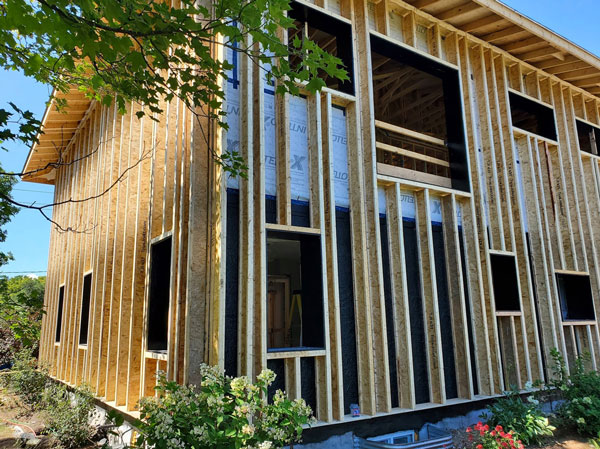Climate and Construction: NBC public review draws both support and pushback – Daily Commercial News
Climate and Construction: NBC public review draws both support and pushback Daily Commercial News


The 2020-2025 National Building Code (NBC) and Sustainable Development Goals
The initial public review period in the 2020-2025 National Building Code (NBC) development cycle drew to a close at the end of April.
Support for Sustainable Development Goals
Energy efficiency advocates like Passive House Canada (PHC) and Efficiency Canada are generally supportive of what has come forth so far. This includes improved air tightness, an energy-efficiency intensity compliance path, carbon reduction, continued tiered code adoption, and support for municipalities as they seek to elevate building performance and emissions reductions, particularly through advancing green development standards.
“These changes represent a progressive shift towards performance-based standards, which, if widely adopted, could substantially decrease the operational emissions associated with new and retrofitted buildings,” PHC recently wrote in its newsletter.
Concerns and Disagreements
However, PHC did express concerns regarding the “uneven requirement for airtightness testing, multiple compliance pathways that keep the door open to reduced performance, a lack of ambitious sunsetting of high emitting energy systems, a lack of improvement in energy efficiency in the lower tier, and the voluntary nature of advanced tiers.” PHC and Efficiency Canada also disagree with a proposal that includes a points system where high GHG sources, such as gas heaters, are awarded points equivalent to more efficient technologies like heat pumps.
“If the goal of the net-zero emissions code is indeed to decarbonize the buildings sector, there will be a substantial role for the use of low-emissions electricity heat pumps that produce fewer emissions than gas alternatives,” says Efficiency Canada.
Blend of Prescriptive and Performance Standards
The NBC also still runs a blend of prescriptive and performance standards. PHC suggests, “multiple pathways complicate the compliance process and could lead to inefficiencies and redundancies in the design process by requiring multiple models for different aspects of the same project.”

met with both cautious optimism and skepticism.
Importance of Performance-based Code Structures
Performance-based code structures will deliver results superior to prescriptive measures, it says.
Concerns about Costs
The homebuilding industry appears concerned about costs more than energy efficiency. Richard Lyall, president of the Residential Construction Council of Ontario (RESCON), claims energy efficiency measures add to costs without any substantial return on that investment. To prove his point, he cites a study, undertaken by RESCON and Ontario new home builder Country Homes back in 2021.
Two halves of a semi-detached home were analyzed. One half was “an all-electric home designed and built to the Canadian Home Builders’ Association NetZero energy (NZE) program”; the other half was “a low-carbon home utilizing fuel-switching, combination hybrid gas and electric heat.”
However, some cost conclusions were misleading. For example, solar panels added significantly to the price of the NZE home. However, renewables like solar are not a requirement of the “NZE-ready” standard in the current national model codes.
Overall, Lyall would prefer to lower code ambitions and slow the pace of any development. “Moving too far beyond the current building code requirements for energy efficiency measures can result in a negative return on investment,” he writes. “Moving too quickly in adopting energy efficient measures without proper consideration of the merits could lead to other problems.”
He speaks specifically of skilled trade shortages. “The push for more energy efficiency measures in new homes could be the straw that breaks the camel’s back.”
Net-Zero Energy-Ready Standards by 2030
But as Efficiency Canada explains: “The end goal of Canada’s 2020 national model codes is that all new buildings will be built to net-zero energy-ready standards by 2030.” That leaves ample time for builders, associations, and governments to share best practices on how to cost-effectively achieve that standard in the coming years.
In any case, Lyall asserts Ontario’s new homebuilders, “are already leaders and a decade ahead of other provinces when it comes to energy-efficient practices,” despite what he describes as “crippling taxes, fees, and levies.”
Yet, Ontario has not adopted the NBC tiered approach and still operates under 2017 NBC provisions. This denies builders a predictable regulatory and cost-effective path to eventually meet the NZE-ready standard in 2030, and for the supply chain to forecast future demand for higher performing products.
Reduced regulatory uncertainty would help control new housing costs. After all, that is what Lyall is talking about.
John Bleasby is a Coldwater, Ont.-based freelance writer. Send comments and Climate and Construction column ideas to editor@dailycommercialnews.com.
SDGs, Targets, and Indicators
1. Which SDGs are addressed or connected to the issues highlighted in the article?
- SDG 7: Affordable and Clean Energy
- SDG 9: Industry, Innovation, and Infrastructure
- SDG 11: Sustainable Cities and Communities
- SDG 13: Climate Action
The issues highlighted in the article are related to energy efficiency, building performance, emissions reductions, and decarbonization of the buildings sector. These align with the goals of SDG 7 (Affordable and Clean Energy), SDG 9 (Industry, Innovation, and Infrastructure), SDG 11 (Sustainable Cities and Communities), and SDG 13 (Climate Action).
2. What specific targets under those SDGs can be identified based on the article’s content?
- Target 7.3: By 2030, double the global rate of improvement in energy efficiency
- Target 9.4: By 2030, upgrade infrastructure and retrofit industries to make them sustainable
- Target 11.6: By 2030, reduce the adverse per capita environmental impact of cities, including by paying special attention to air quality and municipal and other waste management
- Target 13.2: Integrate climate change measures into national policies, strategies, and planning
The article discusses the need for improved energy efficiency in buildings, retrofitting industries for sustainability, elevating building performance and emissions reductions in municipalities, and decarbonizing the buildings sector. These align with the targets mentioned above.
3. Are there any indicators mentioned or implied in the article that can be used to measure progress towards the identified targets?
- Indicator 7.3.1: Energy intensity measured in terms of primary energy and GDP
- Indicator 9.4.1: CO2 emissions per unit of value added
- Indicator 11.6.1: Proportion of urban solid waste regularly collected and with adequate final discharge out of total urban solid waste generated, by cities
- Indicator 13.2.1: Number of countries that have communicated the strengthening of institutional, systemic, and individual capacity-building to implement adaptation, mitigation, and technology transfer
The article mentions the need for improved energy efficiency, carbon reduction, and emissions reductions in buildings. These can be measured using indicators such as energy intensity, CO2 emissions per unit of value added, and the proportion of urban solid waste properly managed. The integration of climate change measures into policies and planning can be measured by the number of countries strengthening their capacity for adaptation, mitigation, and technology transfer.
Table: SDGs, Targets, and Indicators
| SDGs | Targets | Indicators |
|---|---|---|
| SDG 7: Affordable and Clean Energy | Target 7.3: By 2030, double the global rate of improvement in energy efficiency | Indicator 7.3.1: Energy intensity measured in terms of primary energy and GDP |
| SDG 9: Industry, Innovation, and Infrastructure | Target 9.4: By 2030, upgrade infrastructure and retrofit industries to make them sustainable | Indicator 9.4.1: CO2 emissions per unit of value added |
| SDG 11: Sustainable Cities and Communities | Target 11.6: By 2030, reduce the adverse per capita environmental impact of cities, including by paying special attention to air quality and municipal and other waste management | Indicator 11.6.1: Proportion of urban solid waste regularly collected and with adequate final discharge out of total urban solid waste generated, by cities |
| SDG 13: Climate Action | Target 13.2: Integrate climate change measures into national policies, strategies, and planning | Indicator 13.2.1: Number of countries that have communicated the strengthening of institutional, systemic, and individual capacity-building to implement adaptation, mitigation, and technology transfer |
Copyright: Dive into this article, curated with care by SDG Investors Inc. Our advanced AI technology searches through vast amounts of data to spotlight how we are all moving forward with the Sustainable Development Goals. While we own the rights to this content, we invite you to share it to help spread knowledge and spark action on the SDGs.
Fuente: canada.constructconnect.com

Join us, as fellow seekers of change, on a transformative journey at https://sdgtalks.ai/welcome, where you can become a member and actively contribute to shaping a brighter future.







